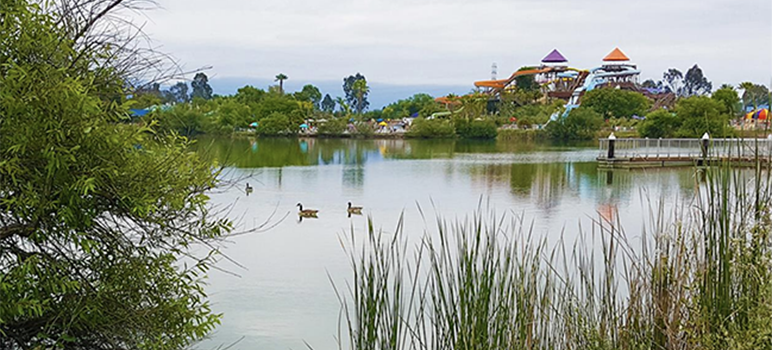For decades, Valley Water has been committed to helping keep communities safe by reducing flood risks in Santa Clara County. Our flood protection projects and programs balance environmental stewardship and urban demands with the needs of the community. This year, we’re enthusiastic about the progress of two important projects that will help protect the communities of East San Jose.
Cunningham Flood Detention
Lake Cunningham is a manmade body of water that allows the community to enjoy a tranquil setting and recreational activities. Built in coordination with the city of San Jose in the 1980s, it serves a dual function as a flood detention facility. During strong storms, the park helps capture excess flows of water from Lower Silver Creek, reducing flood risks for neighboring homes and business.
Valley Water has been working on improving Lake Cunningham Park which is adjacent to the recently completed Lower Silver Creek Flood Projection Project. Now that Lower Silver Creek has been upgraded to withstand higher flows, Valley Water wants to ensure Lake Cunningham can also capture potential higher flows.
Improvements on Lake Cunningham began last summer and are well under way. Construction of a flood wall adjacent to Cunningham Avenue and White Road is almost complete. Work on levees on Lower Silver Creek recently started. The project is anticipated to be completed this summer. The park will have new tree plantings, a new trash compactor and new pedestrian access.
Together with the improvements from the Lower Silver Creek Flood Protection Project, this work will help protect about 3,200 homes and businesses in the floodplain and downstream of the park from a 100 year-flood, or a flood that has a one percent chance of happening any given year.
Coyote Creek Flood Protection
Coyote Creek is our county’s longest waterway, spanning through three cities before it drains to the San Francisco Bay. In 1995 Valley Water completed a flood protection project from the bay to Montague Expressway. But much of the stream further upstream is a natural channel which runs through densely populated neighborhoods.
A previous study, aimed at providing 100-year flood protection along the creek from Montague Expressway to Highway 280, determined the cost of such a project ranged from $500 million to $1 billion. Valley Water sought to obtain federal financial support for the project, but was unsuccessful.
During the February 2017 flood, Coyote Creek overtopped at several locations between Montague Expressway and Tully Road. In June of 2017, the Valley Water board of directors voted to modify the previous Coyote Creek project by extending the project limits 2.9 miles upstream to Tully Road (to include impacted neighborhoods) and revising the target protection level from 100-year flood to a flood equivalent to the February 2017 storm (approximately a 20-to-25-year flood). These modifications allow us to pursue a project with local allocated funding that will help protect the community from future storms. We can also implement practical solutions that may prevent considerable in-channel work and possibly reduce time in extensive permitting.
The 2017 event was the largest flood observed for Coyote Creek since Anderson Dam was completed in 1951 and allowed us to do a thorough study of the creek’s current conditions. Valley Water staff has recently compiled a detailed assessment in a problem definition report which outlines the creek’s history, hydrology and challenges, as well as some initial opportunities for reducing flood risks to homes and businesses.
This report will be presented to the community this spring through our Coyote Creek Ad Hoc Committee. The project team will develop potential project options and feasible alternatives with the help of public and stakeholder input. We will need continued community and agency support in reducing flood risks in our region. We hope we can count on you to let your neighbors, community and public officials know of the urgency and importance of completing these projects.
To sign up to receive project updates or subscribe to the district newsletter, click here.
Tony Estremera serves on the Valley Water Board of Directors, representing District 6, which spans a broad swath of east and south San Jose, including the neighborhoods of Alum Rock and Seven Trees. Opinions are the author’s own and do not necessarily reflect those of San Jose Inside. Send op-ed pitches to
je*******@me*******.com
.


Why does this sound like a can being kicked down the road another 20 years. Ping………ding……..pop……. roll,roll,roll.